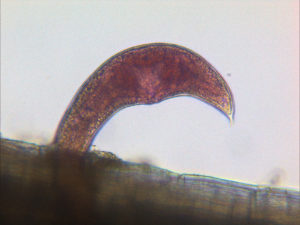By Mojtaba Zaifnejad, Ph.D.
Sr. Director of Field Research and Technical Services,
Huma, Inc.®

Know Them Better
Reniform nematodes are one of the ten species of Rotylenchulus. They are tiny, soil-dwelling, and plant-parasitic nematodes that have become a significant concern in modern agriculture for causing yield damage and economic losses.
They are called reniform because the mature female has the shape of a kidney bean. Reniform nematodes are sedentary semi-endoparasitic, meaning stationary and partially immersed in plant cells. The female penetrates a plant root with its head portion and stays embedded in the root and the tail section extends beyond root surface. Male remains outside of the root. Between 60 to 200 eggs are deposited by female and it takes one to two weeks for them to hatch. Generally male and female are required for reproduction. However, the egg production of some reniform nematodes occurs without fertilization. The life cycle of reniform is around three weeks. Under environmental stress conditions they can enter a static survival phase and live without nourishment for a much longer time. The average size of reniform nematode is around 0.45 mm.
Reniform nematode (Rotylenchulus reniformis): Female – Stained Red
Impact on Plant Health
Over 300 plant species are affected by reniform nematodes worldwide. Cotton, beans, tomato, lettuce and pineapple are some of the affected crops. Cotton is particularly vulnerable to these nematodes, and in some cases, yield losses of up to 90% have been reported.
Reniform nematodes penetrate, feed on and damage root cells and disrupt their functions. Then damaged roots cannot efficiently uptake and translocate nutrients and water to the rest of a plant. This stunts plant growth, revealing nutrient deficiency, malformed roots, and increased susceptibility to other diseases. It’s concerning that the symptoms of reniform nematode infestations can be easily misdiagnosed as nutrient deficiencies or other root diseases, thus making it crucial to identify the nematodes accurately.
Economic Consequences
Reniform nematodes pose significant economic challenges for agriculture, affecting crop yields, quality, and production costs. The impact is not limited to individual farmers but also extends to regional and national economies, trade, and environmental sustainability. For example, the annual estimated loss by cotton growers in the U.S. has reached $130M so far. In some studies, researchers noticed cotton yield loss of over 50%.
Identification, Symptoms, Controlling and Managing
Accurate identification of reniform nematodes is critical for implementing effective management strategies. Nematode extraction and identification involve soil sampling, processing, and microscopic examination. Numerous specialized laboratories and agricultural extension services offer nematode diagnostic services to aid farmers in identifying the nematode species present in their fields. Testing soil and plants will help to separate nematode damage from other biotic and abiotic crop damages.
It can be hard to diagnose the reinform nematode damage at first. Reniform nematode affected plants become chlorotic and stunted. In some cases, the leaves show interveinal chlorosis. The roots become developed and stunted as well. When its population is low, the plant damage appears patchy in the field, but as the infestation spreads throughout the field, the plant damage becomes uniform.
Controlling and managing reniform nematodes includes the usage of chemicals, microbes, field sanitation, crop rotation, resistant cultivars, and varieties. Various chemical and application methods are used to manage reniform-infested fields. However, the effectiveness of these strategies depends on factors such as nematode population density, soil conditions, and crop varieties used.
It can be difficult to find nematicides that are safe for the soil, environment and handlers and yet be effective against reniform nematode. In a university study, the application of a thyme oil based bionematicide called Huma Promax combined with a biostimulant material, Zap, successfully decreased Rotylenchulus reniformis population in soil. This resulted in a slightly higher yield in soybeans crops. Dr. T. Watson of Louisiana State University said, “Overall, Promax and Zap application regimes show promising potential to suppress reniform nematode in soybeans in Louisiana.” Some have tried to adjust soil molybdenum concentrations to manage nematode infestations.
Conclusion
I believe that in the world of agriculture, knowledge truly is power. And, when it comes to the notorious reniform nematodes, this knowledge becomes the key to victory. Armed with a deeper understanding of their behavior, detection methods, and management strategies, we can fortify our fields against the destructive influence of reniform nematodes.
Related Posts

This Week in Ag #15
“Your rows sure are straight.” Those may have been the most pride-filling words I ever heard. They were first spoken to me by one of my landlords, Orville Larson, the spring after my dad passed away and all farming operations fell entirely on me. Orville made a habit of driving out to his farm to see

This Week in Ag #51
Back in the mid-1980s, this then-high school student attended a farmer meeting with dad. One of the speakers was a commodities advisor. He playfully asked the attendees what their target price was for their crops. He further inquired, “How many of you are still holding out for the return of $12 soybeans?” The sheepish looks

Bio Huma Netics Achieves Responsible Ag Certification
Bio Huma Netics, Inc. (BHN), the maker of Huma Gro® and Fertilgold® Organics crop nutrition and protection products, has achieved Responsible Ag certification for its fertilizer manufacturing facilities. Responsible Ag is the only program in the nation that provides a voluntary comprehensive assessment of a fertilizer manufacturer’s compliance with federal regulations. Certification requires that a


